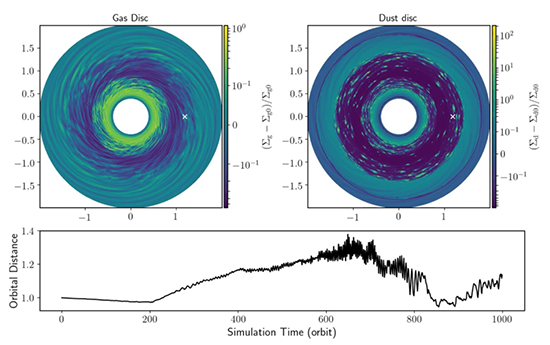研究成果藝廊 > 理論天文物理理論天文物理
(Theory)
研究成果藝廊
理論天文物理理論天文物理 (Theory)
| Planet migration in dusty protoplanetary disks |
|
圖片來源: Hsieh & Lin (2020)

Numerical simulation of low-mass planets migrating in dust-laden protoplanetary disks. The top panels show the perturbed gas and dust densities in the disk with initial metallicity 0.3 and particle Stokes number 0.06. The planet location is marked by the white cross. The bottom panel shows the orbital evolution of the two-Earth-mass planet. The planet migration behavior becomes chaotic after 200 orbits once numerous small-scale vortices formed in the vicinity of the planet.
|
| Planets are born in protoplanetary disks (PPDs). In standard, gas-dominated disks, low-mass planets undergo rapid inwards migration and are lost to the central star. A key challenge in planet formation theory is, therefore, how to slow down the migrating planets or even reverse their migration directions, so that they could evolve into the planetary systems we observed. However, in dust-laden disks, various dust substructures are found to form in the vicinity of the planet that can have significant dynamical effects on disk-planet interaction. Hsieh & Lin (2020) simulated the migration behavior of low-mass planets in dusty PPDs with various metallicities and particle Stokes numbers. We uncovered a new regime of stochastic migration applicable to disks with abundant large dust grains (see the figure). In this case, the planet starts off migrating inwards smoothly. But after 200 orbits, numerous small-scale dust vortices formed in the disk continuously scatter the planet, causing its migration to become stochastic, which effectively halt the initial inwards migration and reverse the migration direction. |
